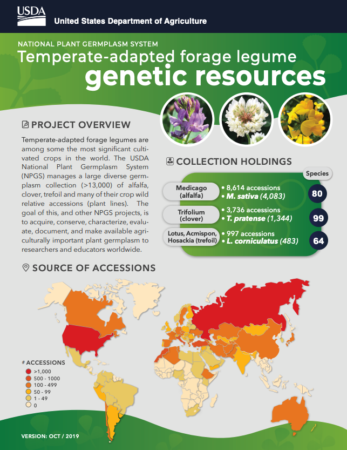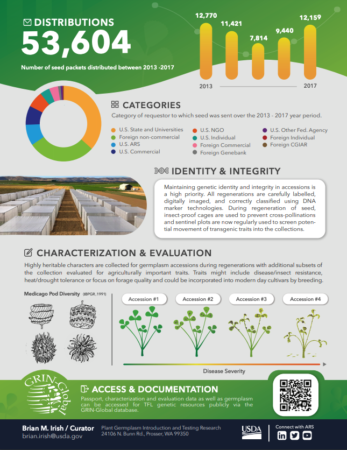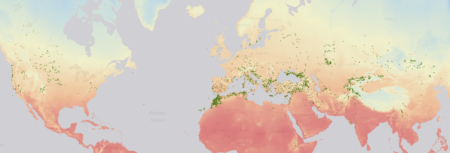- Breeding chillis for mechanization.
- Long, but very engaging, video on zooarchaeology in general and goat bones in particular.
- Delving into the origins of the sweetpotato at CIP.
- Cultivating Leptospermum scoparium for honey.
- Saving languages.
- Jasmonic acid is bad for sorghum yields.
Brainfood: Tree SDM, TR4 in Colombia, Genebanks double, Pacific ag, Gums, Defaunation, Oil palm, Agroforestry, Moldy cheese, Ecosystem services, Meat, Desert ag, Maize evolution
- Species distribution modelling to support forest management. A literature review. Embrace the uncertainty.
- First report of Fusarium wilt Tropical Race 4 in Cavendish bananas caused by Fusarium odoratissimum in Colombia. Inevitable.
- Seed Banking as Future Insurance Against Crop Collapses. “Although the basic technology of seed- (gene-)banking is relatively simple, there are nonetheless significant costs involved in effectively managing seed- (gene-)bank collections.” Elevator pitch desperately needed.
- Rapid loss of seed viability in ex situ conserved wheat and barley at 4°C as compared to −20°C storage. Colder the better.
- Origin and Development of Agriculture in New Guinea, Island Melanesia and Polynesia. Maybe 5-6 distinct stages since 7000 BP.
- Exotic eucalypts: From demonized trees to allies of tropical forest restoration? Maybe.
- Quantifying the impacts of defaunation on natural forest regeneration in a global meta-analysis. Forests need vertebrates. No word on where eucalypts stand.
- Market-mediated responses confound policies to limit deforestation from oil palm expansion in Malaysia and Indonesia. Bans are not enough…
- The ‘Capitalist Squeeze’ and the Rise and Fall of Sumatra’s Krui Agroforests. …you need active forest conservation too.
- Rapid Phenotypic and Metabolomic Domestication of Wild Penicillium Molds on Cheese. Wild molds adapt to cheese, can eventually make camembert.
- A global synthesis reveals biodiversity-mediated benefits for crop production. Need species richness for pollination, biological pest control and final yields.
- Animal source foods: Sustainability problem or malnutrition and sustainability solution? Perspective matters. Let them eat meat.
- The vitality of fruit trees in ancient Bedouin orchards in the Arid Negev Highlands (Israel): Implications of climatic change and environmental stability. Recycling centuries-old infrastructure in the desert.
- The Genomic Basis for Short-Term Evolution of Environmental Adaptation in Maize. Significant shift in adaptation of tropical landrace to temperate conditions in 10 generations with little loss of genetic diversity.
Genebanks everywhere on NPR
Just realized that my last two stories involved gene banks. Shouldn't there be some sort of award for that?
— Dan Charles (@DanCharlesNow) October 31, 2019
I’m all for it, but judge for yourselves. Here are the two stories involved:
- From Culinary Dud To Stud: How Dutch Plant Breeders Built Our Brussels Sprouts Boom. By looking into their genebanks, of course, to find less bitter varieties.
- Most U.S. Dairy Cows Are Descended From Just 2 Bulls. That’s Not Good. But fortunately there’s heritage semen in the fridge.
Brainfood: Neolithic dairy, Wheat phenology, Carob origin, Malawi diets, Maize evolution, Bean domestication, Human evolution & diets, Chickpea pre-breeding, Food trade, Scaling up conservation, Apple leaves, Winged bean nutrition, White clover pedigrees, Bushmeat
- Milk of ruminants in ceramic baby bottles from prehistoric child graves. Neolithic sippy cups. Cute.
- Heat and Drought Stress Advanced Global Wheat Harvest Timing from 1981–2014. 2.5 days per decade.
- A strong east–west Mediterranean divergence supports a new phylogeographic history of the carob tree (Ceratonia siliqua, Leguminosae) and multiple domestications from native populations. No evidence of an eastern refugium.
- Value chains to improve diets: Diagnostics to support intervention design in Malawi. You can modify existing social protection interventions to optimize diets (including increasing diet diversity) by enhancing public- and private-sector linkages.
- Contemporary evolution of maize landraces and their wild relatives influenced by gene flow with modern maize varieties. Landrace genetic diversity actually increased due to introgression from modern varieties.
- Ancient genomes reveal early Andean farmers selected common beans while preserving diversity. Because they applied weak selection. Can breeders learn from this? Also, is it similar for maize?
- Reconstruction of nine thousand years of agriculture-based diet and impact on human genetic diversity in Asia. Changes in diet through domestication and processing have left signatures on the human genome.
- Transgressive segregations for agronomic improvement using interspecific crosses between C. arietinum L. x C. reticulatum Ladiz. and C. arietinum L. x C. echinospermum Davis species. For things like pod number, earliness and tolerance to cold.
- Linking global crop and livestock consumption to local production hotspots. China is the largest consumer of primary crops, and the third largest consumer of livestock. The Corn Belt, cerrado, Europe and E. China feeds it, and the world.
- How conservation initiatives go to scale. With great difficulty.
- Morphometrics Reveals Complex and Heritable Apple Leaf Shapes. It’s mainly about aspect ratio.
- Nutrient and Antinutrient Composition of Winged Bean (Psophocarpus tetragonolobus (L.) DC.) Seeds and Tubers. The best, and worst, among 50 accessions. Spoiler alert: it depends on the nutrient, and on whether you prefer the seeds or tubers.
- Identification of Founding Accessions and Patterns of Relatedness and Inbreeding Derived from Historical Pedigree Data in a White Clover Germplasm Collection in New Zealand. 15,000 accessions trace to about 175 founders.
- Poverty not taste drives the consumption of protected species in Madagascar. Let them eat domestic livestock meat.
Temperate forages at the NPGS
We just got hold of a very neat infographic summarizing the work of the USDA’s National Plant Germplasm System on the Management of Temperate-adapted Forage Legume Genetic Resources and Associated Information.
If you were to scan that QR code, you’d get here, and be able to select and order material from the USDA’s GRIN-Global site.
Here’s the distribution of over 6000 USDA-held accessions of Medicago, Trifolium and Lotus with geographical coordinates according to Genesys.
The colours show annual mean temperature.


